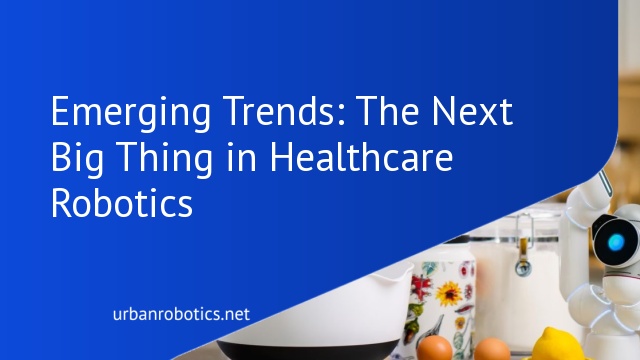As we look towards the future of patient care and medical procedures in the United States, it is clear that emerging trends in healthcare robotics are set to revolutionize the industry. These trends, driven by advancements in technology, have the potential to transform the way we deliver healthcare and improve patient outcomes.
With the healthcare IT market projected to reach $857.6 billion by 2030, it is evident that the future of healthcare lies in digital innovation. Around 80% of health systems are planning to increase their investment in digital healthcare, highlighting the growing importance of technology in the industry.
So, what are these emerging trends in healthcare robotics? They include the Internet of Medical Things (IoMT), cybersecurity and data privacy, remote patient monitoring (RPM), improved big data analytics, cloud migration, robotic process automation (RPA), cognitive automation (CA), FinTech integration, interoperability and connectivity, telehealth, data breach prevention, and network strategies.
These trends are already transforming patient care and medical procedures in the United States. From wearable devices and remote patient monitoring to AI-powered diagnostics and virtual reality applications, healthcare robotics is paving the way for a new era of healthcare delivery.
Join us as we explore each of these emerging trends in detail and uncover the exciting possibilities they hold for the future of healthcare in the United States.
Internet of Medical Things (IoMT)
The Internet of Medical Things (IoMT) is a rapidly growing field in healthcare that leverages the power of connectivity and technology to revolutionize patient care. With the global IoMT market projected to reach $960.2 billion by 2030, it is clear that this innovative approach is here to stay.
One of the key aspects of IoMT is the use of wearable devices. These devices, such as fitness trackers and smartwatches, provide real-time and detailed data on patients’ health states. This wealth of information allows healthcare professionals to monitor patients remotely and make more informed decisions about their care.
Remote patient monitoring (RPM) is a prime example of how IoMT is transforming healthcare. Through the use of connected devices, healthcare providers can monitor patients’ vital signs and health conditions from a distance. This not only improves patient convenience but also enables early detection of potential issues, leading to timely interventions and improved outcomes.
The Benefits of IoMT for Healthcare Professionals
For healthcare professionals, IoMT offers numerous benefits. Firstly, it allows for more efficient and accurate data collection. Instead of relying on patients to manually record their health information, wearable devices automatically capture and transmit the data, eliminating the potential for human error.
Secondly, IoMT enables healthcare professionals to actively participate in their patients’ treatment plans. By receiving real-time notifications and insights, doctors can closely monitor their patients’ progress, make adjustments to their care plans as needed, and provide timely guidance and support.
Lastly, IoMT enhances the overall quality of patient care. With access to real-time data and insights, healthcare professionals can offer personalized and proactive interventions. They can spot trends, identify potential risks, and intervene before serious complications arise, resulting in improved patient outcomes and a higher standard of care.
| Benefits of IoMT for Healthcare Professionals: |
|---|
| Efficient and accurate data collection |
| Active participation in patient treatment plans |
| Enhanced quality of patient care |
Cybersecurity and Data Privacy
Data security is a crucial concern in the healthcare industry. The sensitive nature of healthcare data makes it a prime target for cyberattacks and data breaches. In fact, the healthcare sector experienced over 40 million compromised healthcare records in 2021 alone. To safeguard patient information and comply with regulations, healthcare organizations are taking proactive measures to enhance cybersecurity and data privacy.
One key aspect of cybersecurity in healthcare is the implementation of HIPAA-compliant video conferencing platforms. These platforms provide a secure means of communication between healthcare professionals and patients, ensuring that sensitive medical information remains protected. By using encrypted connections and stringent access controls, these video conferencing platforms prevent unauthorized access and protect patient privacy. As the healthcare market continues to evolve, there will be a growing demand for secure and reliable software solutions that adhere to patient safety standards and effectively prevent data breaches.
The Importance of Data Privacy
In an era of digital transformation, data privacy is paramount. Healthcare organizations must not only secure patient data but also ensure that it is used responsibly and ethically. Patients have the right to know how their data is being collected, stored, and used. Transparency and consent are key principles in maintaining trust between healthcare providers and patients.
| Data Privacy Measures | Description |
|---|---|
| Secure Data Storage | Adopting robust encryption methods and secure storage solutions for safeguarding patient data from unauthorized access. |
| Data Access Controls | Implementing strict access controls to ensure that only authorized personnel can access and modify patient data. |
| Regular Audits and Monitoring | Conducting routine audits and monitoring systems for vulnerabilities, detecting potential breaches, and preventing unauthorized access. |
| Staff Training and Awareness | Providing comprehensive training to staff on data privacy best practices, including identifying and reporting potential security risks. |
| Compliance with Regulations | Adhering to regulatory requirements, such as the Health Insurance Portability and Accountability Act (HIPAA), to ensure data privacy and protection. |
By implementing robust cybersecurity measures and prioritizing data privacy, healthcare organizations can mitigate the risks associated with cyberattacks and data breaches, ultimately safeguarding patient information and maintaining trust in the healthcare system.
Remote Patient Monitoring (RPM)
Remote Patient Monitoring (RPM) is emerging as a vital component of modern healthcare, revolutionizing the way we deliver healthcare intervention. RPM systems enable continuous monitoring of patients’ health data, allowing healthcare providers to remotely track their progress and intervene when necessary. This technology has gained significant traction in recent years and is projected to drive the growth of the RPM systems market, which is estimated to be worth over $175.2 billion by 2027.
RPM offers numerous benefits in healthcare delivery, particularly in the context of telemedicine. By leveraging RPM, healthcare professionals can monitor high-risk patients from a distance, ensuring timely intervention and reducing the need for in-person visits. This real-time monitoring enables early detection of any complications or worsening conditions, leading to proactive healthcare management. Through RPM, patients can also take an active role in their own care, as they gain access to real-time data about their health status, fostering greater awareness and self-management.
The COVID-19 pandemic has further accelerated the adoption of RPM and telemedicine, as healthcare providers sought alternative ways to deliver care while minimizing physical contact. With RPM, patients can receive the necessary medical attention without leaving the safety of their homes. This technology enables healthcare professionals to remotely assess patients’ vital signs, such as blood pressure, heart rate, and blood sugar levels, among others, ensuring continuous monitoring and prompt intervention when needed. The convenience and efficiency of RPM have transformed healthcare delivery, enhancing patient outcomes and improving overall healthcare accessibility.
The Benefits of Remote Patient Monitoring (RPM)
Let’s take a closer look at some key benefits of Remote Patient Monitoring (RPM):
- Enhanced healthcare intervention and proactive management of chronic conditions
- Real-time monitoring of vital signs and health parameters
- Reduced hospital readmissions and unnecessary emergency room visits
- Improved patient engagement and empowerment through access to real-time health data
- Cost savings for both patients and healthcare systems
| RPM Benefits | Description |
|---|---|
| Enhanced healthcare intervention and proactive management of chronic conditions | RPM allows healthcare professionals to closely monitor patients with chronic conditions, providing timely intervention and personalized care plans. |
| Real-time monitoring of vital signs and health parameters | RPM systems enable continuous tracking of patients’ vital signs, such as blood pressure, heart rate, and glucose levels, ensuring early detection of any abnormalities. |
| Reduced hospital readmissions and unnecessary emergency room visits | With RPM, healthcare providers can promptly identify deteriorating health conditions and intervene before they escalate, reducing the need for hospital readmissions and emergency room visits. |
| Improved patient engagement and empowerment through access to real-time health data | RPM empowers patients to take an active role in their own care by providing them with real-time access to their health data, fostering engagement and self-management. |
| Cost savings for both patients and healthcare systems | RPM eliminates the need for frequent in-person visits, reducing healthcare costs for patients while optimizing resource allocation for healthcare systems. |
Artificial Intelligence (AI) and Machine Learning (ML)
Artificial Intelligence (AI) and Machine Learning (ML) technologies are transforming medical decision-making and diagnostics. The integration of AI and ML algorithms in healthcare processes has revolutionized the industry by enhancing the speed and accuracy of medical analyses. These technologies are reshaping the future of healthcare and improving patient outcomes.
The Role of AI in Medical Decision-Making
AI-powered diagnostics have proven invaluable in providing clinicians with advanced tools to aid in their decision-making process. By analyzing vast amounts of medical data, AI algorithms can identify patterns and subtle indicators that might be missed by human observation alone. This enables more accurate diagnoses and helps medical professionals create personalized treatment plans tailored to each patient’s unique characteristics.
Advancements in Precision Medicine
AI and ML technologies have also played a vital role in advancing precision medicine. By leveraging genomic data, clinical records, and other relevant information, AI algorithms can identify genetic markers and predispositions that contribute to disease development. This information allows healthcare providers to develop targeted treatment plans that address the specific needs of each patient, leading to more effective and personalized care.
| Benefits of AI and ML in Healthcare | Examples |
|---|---|
| Improved diagnostics | AI-powered imaging analysis for early detection of cancer |
| Enhanced treatment planning | AI algorithms for determining optimal drug dosage based on patient characteristics |
| Streamlined administrative tasks | ML-powered systems for automated medical coding and billing |
| Real-time monitoring and predictive analytics | AI algorithms for identifying patients at high risk of readmission |
The Future of AI and ML in Healthcare
The potential of AI and ML in healthcare is vast and continues to expand. As these technologies evolve, we can expect further advancements in areas such as robotics-assisted surgery, drug discovery, and population health management. However, it is essential to ensure that ethical considerations and data privacy regulations are closely adhered to, maintaining a balance between innovation and patient safety.
Virtual Reality (VR) and Augmented Reality (AR)
Virtual Reality (VR) and Augmented Reality (AR) are revolutionizing medical applications. With immersive digital solutions, we are entering a new era in medical training, diagnosis, and treatment.
VR technology allows medical professionals to immerse themselves in digitally constructed environments, enhancing their learning experience and refining their skills. Through realistic simulations, healthcare providers can practice complex procedures, such as surgeries, in a safe and controlled environment. This immersive training helps us improve our expertise, increase confidence, and ultimately enhance patient outcomes.
On the other hand, AR overlays digital information onto the physical world, creating an enhanced reality. In diagnostic imaging, AR assists physicians in gaining a deeper understanding of underlying medical issues. By superimposing virtual 3D models onto real-time imaging scans, doctors can visualize and analyze complex anatomical structures more effectively. This technology enables precise diagnoses and enhances treatment planning, resulting in better patient care.
Furthermore, VR and AR have found applications beyond training and diagnostics. In physical therapy, VR can be used to create engaging and motivational exercises that aid in rehabilitation. Patients can immerse themselves in virtual environments and interact with simulated objects, making therapy sessions more enjoyable and effective. These immersive experiences can also help reduce pain and anxiety during medical procedures, providing a more comfortable and positive healthcare experience.





